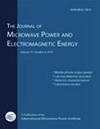Effect of microwave radiation on the magnetic properties of ludwigite and iron-boron separation
IF 1.5
4区 工程技术
Q4 ENGINEERING, CHEMICAL
Journal of Microwave Power and Electromagnetic Energy
Pub Date : 2021-04-12
DOI:10.1080/08327823.2021.1916682
引用次数: 0
Abstract
Abstract To effectively separate and recover the valuable elements iron and boron from ludwigite, this study investigated the magnetic properties and the magnetic separation efficiency. And the reactivity of boron component in the B-bearing tailing was studied. The results indicated that the saturation magnetization of ore samples was increased with the increase of microwave power and heating time. Under condition of 40 s with 4 kW, the saturation magnetization of ore samples increased from 12.73 emu/g for the raw ore to 24.70 emu/g for the treated ore, an increased of 94.03%. After magnetic separation, the grade and recovery rate of iron in the iron concentrate and the boron grade in the tailing for the treated sample with 4 kW for 40 s were increased by 19.74%, 31.46% and 86.46% in comparison with those of the untreated ore. The sample was heated to 600 °C at 4 kW and held for 20 min, the reactivity of boron component in the B-bearing tailing reached 86.68 wt%, which increased by 34.01% compared with that of the raw ore and 4.43% compared with that of the optimal traditional roasting value at 700 °C for 2 h, indicating that the roasting temperature and time were obviously decreased and the reactivity was significantly improved by the microwave radiation.微波辐射对铁硼铁矿磁性能的影响
摘要为了有效地分离和回收铁、硼等有价元素,研究了铁、硼的磁学性质和磁选效率。并对含硼尾矿中硼组分的反应性进行了研究。结果表明:随着微波功率的增大和加热时间的延长,矿样的饱和磁化强度增大;在40s、4kw条件下,矿样的饱和磁化强度由原矿的12.73 emu/g提高到处理矿的24.70 emu/g,提高了94.03%。磁选后,4 kW处理40 s的铁精矿铁品位、铁回收率和尾矿硼品位分别比未处理的铁精矿铁品位、铁回收率分别提高了19.74%、31.46%和86.46%。4 kW加热至600℃,保温20 min,含硼尾矿中硼组分的反应性达到86.68%;与原矿相比提高了34.01%,与传统最佳焙烧值相比提高了4.43%,说明微波辐射明显降低了焙烧温度和时间,显著提高了反应性。
本文章由计算机程序翻译,如有差异,请以英文原文为准。
求助全文
约1分钟内获得全文
求助全文
来源期刊

Journal of Microwave Power and Electromagnetic Energy
ENGINEERING, CHEMICAL-ENGINEERING, ELECTRICAL & ELECTRONIC
CiteScore
2.50
自引率
6.70%
发文量
21
期刊介绍:
The Journal of the Microwave Power Energy (JMPEE) is a quarterly publication of the International Microwave Power Institute (IMPI), aimed to be one of the primary sources of the most reliable information in the arts and sciences of microwave and RF technology. JMPEE provides space to engineers and researchers for presenting papers about non-communication applications of microwave and RF, mostly industrial, scientific, medical and instrumentation. Topics include, but are not limited to: applications in materials science and nanotechnology, characterization of biological tissues, food industry applications, green chemistry, health and therapeutic applications, microwave chemistry, microwave processing of materials, soil remediation, and waste processing.
 求助内容:
求助内容: 应助结果提醒方式:
应助结果提醒方式:


